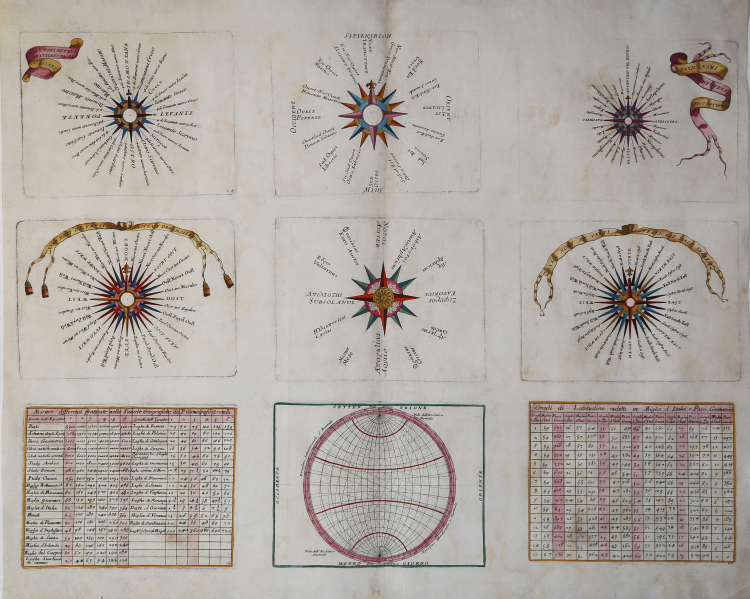




| Reference: | S50368 |
| Author | Vincenzo CORONELLI |
| Year: | 1693 ca. |
| Zone: | Wind Rose |
| Printed: | Venice |
| Measures: | 640 x 491 mm |



| Reference: | S50368 |
| Author | Vincenzo CORONELLI |
| Year: | 1693 ca. |
| Zone: | Wind Rose |
| Printed: | Venice |
| Measures: | 640 x 491 mm |
Plate containing nine illustrations: in the upper and middle part are represented six Roses of the Winds; at the bottom left, in a cartouche there are the different metric scales used by Coronelli for his geographical studies. In the lower right a comparative table between degrees of latitude and metric scales.
The plates are published for the first time in Vincenzo Maria Coronelli's Epitome Cosmografica of 1693. The volume was printed in Cologne, on behalf of the Venetian publisher Andrea Poletti.
The work, dedicated to the Academy of the Argonauts, the first geographical society in the world founded by the same Coronelli, is divided into three books: the first, of 35 chapters, focuses on astronomy and celestial cartography; the second, of 17 chapters, deals with the earth and geography; the third consists of 5 chapters of the first part "che contiene la Descrittione de’ vari globi, che sin hora sono stati fabbricati" and the last 23 chapters of the second part "che contiene la pratica" of the construction of the globes. Each topic corresponds to one of the 38 tables attached to the volume.
Coronelli produced nearly four hundred cosmographic and geographical maps distributed among his major works: Atlante Veneto, Corso Geografico, Isolario, Arcipelago and Biblioteca universale sacroprofana (1701-1709), an alphabetical encyclopedia planned in twenty volumes, of which only the first seven were produced.
The present table is taken from Atlante Veneto.
Copper engraving, beautiful contemporary coloring, in excellent condition.
Vincenzo CORONELLI (Venezia 1650 - 1718)
|
Cosmographer, geographer, biographer, encyclopedist, globe maker, inventor, expert of engeneering and hydraulics. Extraordinarily versatile mind and an extremely tireless man, he produced more than 140 pieces in different genres. At the age of 15, he entered the Franciscan Order, which he then guided as Gran Generale from 1699. He became famous as geographer and mathematician, awakening the interest in these subjects in Italy at the end of the XVII century. He travelled a lot, seeking for all that was new, and keeping a correspondance with the most important intellectuals of his time. In 1681 Louis XIV wanted him to go to France, to entrust him with the task of making two terraqueous globes (Marly Globes), with a diameter of 4 metres. Once he came back to Italy, in 1685, he became Cosmographer of the Venetian Republic, where he taught geography and founded the first geographic accademy, called The Argonauts Accademy. In his whole life he produced more that 500 maps; some of them can be found in his most famous works, such as the Venetian Atlas (1690), the Island Book of the Venetian Atlas (1696-97), the Book of Globes (1693). As far as his scientific method, he didn’t elaborate new cartographic systems, but followed the theories that were considered most popular and effective at his time, based on the Copernican system. The main characteristic of his charts is the high quantity of toponymic and historical information. In his most famous and dense work, the Venetian Atlas, we can find about 1100 plates, 200 of which are extremely technical and this is the reason why it is considered the first Italian atlas to describe and illustrate the whole world with charts and maps. It was published in 13 volumes, starting from 1690, and it took nearly ten years to finish it. It is divided in different parts, the most important are the Atlas itself, then the Island Book, the Corso Geografico and the Teatro delle città.
|
Vincenzo CORONELLI (Venezia 1650 - 1718)
|
Cosmographer, geographer, biographer, encyclopedist, globe maker, inventor, expert of engeneering and hydraulics. Extraordinarily versatile mind and an extremely tireless man, he produced more than 140 pieces in different genres. At the age of 15, he entered the Franciscan Order, which he then guided as Gran Generale from 1699. He became famous as geographer and mathematician, awakening the interest in these subjects in Italy at the end of the XVII century. He travelled a lot, seeking for all that was new, and keeping a correspondance with the most important intellectuals of his time. In 1681 Louis XIV wanted him to go to France, to entrust him with the task of making two terraqueous globes (Marly Globes), with a diameter of 4 metres. Once he came back to Italy, in 1685, he became Cosmographer of the Venetian Republic, where he taught geography and founded the first geographic accademy, called The Argonauts Accademy. In his whole life he produced more that 500 maps; some of them can be found in his most famous works, such as the Venetian Atlas (1690), the Island Book of the Venetian Atlas (1696-97), the Book of Globes (1693). As far as his scientific method, he didn’t elaborate new cartographic systems, but followed the theories that were considered most popular and effective at his time, based on the Copernican system. The main characteristic of his charts is the high quantity of toponymic and historical information. In his most famous and dense work, the Venetian Atlas, we can find about 1100 plates, 200 of which are extremely technical and this is the reason why it is considered the first Italian atlas to describe and illustrate the whole world with charts and maps. It was published in 13 volumes, starting from 1690, and it took nearly ten years to finish it. It is divided in different parts, the most important are the Atlas itself, then the Island Book, the Corso Geografico and the Teatro delle città.
|